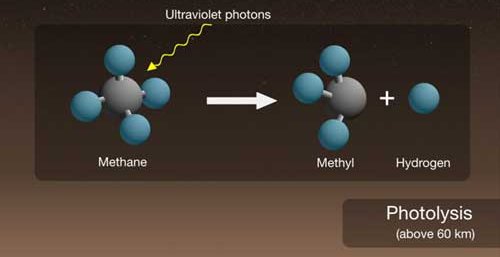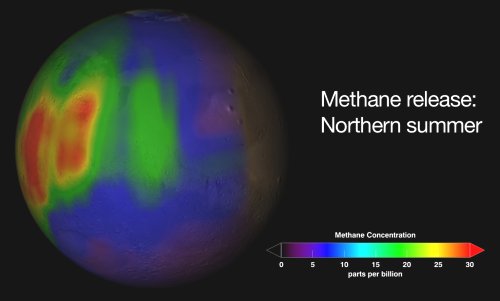In 2003, several groups of scientists discovered evidence of the existence of methane gas in the atmosphere of Mars. They have now completed a survey that spanned the composition of the atmosphere in all seasons over several Martian years. The riddle remains: what is the origin of the methane emanating from at least three sites - geological or perhaps biological

Today's Mars is a world of cold deserts, devoid of life of any kind, at least not on the surface. It does appear that Mars has been cold and dry for billions of years, with such a thin atmosphere, any liquid water on the surface would immediately evaporate. The ultraviolet radiation of the sun also scorches the ground.
The situation looks bleak, but a study published last Thursday in Science Express by a team of scientists from NASA and several universities reveals new hopes for the Red Planet. The first unequivocal detection of methane in the Martian atmosphere indicates that Mars is still alive, either biologically or geologically.
"Methane is a gas that is immediately destroyed in the vaporizing atmosphere in a variety of ways, so the discovery of Stable plumes of methane in the northern hemisphere of Mars in 2003 indicates an ongoing process that releases the gas." said principal investigator Michael Momma of NASA's Goddard Space Flight Center. "In the middle of summer in the Northern Hemisphere, methane is released at a rate equal to that of a massive hydrocarbon leak from a coal and oil field in Santa Barbara, California."
According to him, so far three separate sources have been discovered from which Mars releases methane at this time. "This means we have a window into the processes taking place below the planet's surface."
Methane - four atoms of hydrogen bonded to one atom of carbon - is the main component of natural gas on Earth. It is of interest to astrobiologists, because most of the methane on Earth comes from the living organisms that digest food. However, life is not required to produce this gas. Pure geological processes such as oxidation of iron also produce the gas. "Currently, we do not have enough data to tell whether the source producing the gas is biological or geological - or both." said Momma. "However, the findings do tell us that the planet is still alive, at least in the geological sense. It seems like Mars is challenging us and saying hey, let's find out what methane means."
If microscopic living things are producing the methane, they are probably below the surface, a place that is still warm enough to keep water in a liquid state, as well as a source of energy and supply of carbon, needed by all known forms of life."
"On Earth, microorganisms survive 2-3 kilometers below the Witwatersrand Basin in South Africa, a place where natural radioactivity splits water atoms into molecular hydrogen (H2) and oxygen. The creatures use hydrogen for energy. It is possible that similar creatures could survive for billions of years under the layer of frost on Mars, a place where water is liquid, radiation provides energy, and carbon dioxide - the most common gas in the Martian atmosphere - provides the carbon." said Momma.
"Gases such as methane, which accumulate in these underground areas may be released into the atmosphere if pores or cracks open during the hot season and connect the deep areas to the atmosphere in crater walls or canyons," he said.
"Bacteria that produce methane from hydrogen and carbon dioxide were one of the first forms of life on Earth," said Carl Pilcher, director of NASA's Astrobiology Institute, which partially supported the research. "If life ever existed on Mars, it is reasonable to think that their metabolism would have produced methane from the carbon dioxide in the Martian atmosphere.

However, it is possible that a geological process produces the methane on Mars, whether today or eons ago. On Earth, the process of turning iron oxide (rust) into the group of minerals known as serpentine creates methane, and on Mars this process can operate using water, carbon dioxide and the internal heat of the planet. Another possibility is volcanism: although there is no evidence of active volcanoes on Mars today, it is possible that old methane traps inside ice caves called clathrates may now be released.
The team discovered the methane in Mars by carefully observing Mars over several different Martian years (and all Martian seasons) using a spectrometer attached to infrared telescopes operated by the University of Hawaii and Keck Observatory, both at Mauna Kea, Hawaii.
"We observed and mapped many plumes of methane on Mars, in one of which 19 tons of methane were emitted," said Geronimo Villanova from the Catholic University of America in Washington, DC. Villanova is stationed at NASA's Goddard Center and is a member of Emer. "The plumes were emitted during the hot seasons - spring and summer - apparently because the frost that blocked cracks and fissures evaporated, allowing methane to erupt into the air. Strangely, water vapor was also found in some of the plumes and not in others." said.

According to the team, the plumes were seen over areas where there was evidence of ancient ground ice or channels of flowing water. For example, the plumes appear over areas in the Northern Hemisphere such as eastern Arabia, the Nellie Fossa region, and the southeast quadrant of Citrus Major, an ancient volcano 1,200 kilometers in diameter.
Will need to be used in future missions like The Mars Science Laboratory which will be launched in 2011, to locate the source of the vaporous methane. One way to tell if life is the source of the gas is by measuring the isotope ratios. Isotopes are heavier versions of elements, for example deuterium is a heavier version of hydrogen. In hydrogen-containing molecules such as water or methane, the rare deuterium sometimes replaces the hydrogen atoms. Since life always prefers to use the lighter isotopes, if methane has less deuterium than the water released on Mars, it is a sign that life is producing the methane.
In any case, whether future studies determine that the source of the methane is biological or geological - one thing is clear - Mars is not a dead planet, after all.
For information on the NASA website
On the same topic on the science website:

16 תגובות
Water smears on the wall ecological broadcasts
My husband and the women are ecological
The human mind is formed by ecological darkness and light, we assumed aliens
Hosach changes in the light of ecology, changes in colors, sun lasers, lasers, and guest lasers
ecology
There are aliens on Mars!
It's just like us.
It's like we're in a kind of space below us, there's space up on the sides, everywhere, space is vast and has no end, so maybe if we fly a few years in space, maybe we'll even see another Earth just like us or aliens, so for sure there is life in space, maybe not close to us, maybe they're really, really, far away But there is!!
Half of the planets contain methane, this is not an indication of biological processes.
Michael, you usually sting to the point of exaggeration, but now it was...lol..strong - you brought it in style :)
Yalta:
there is.
Go to the next question.
An Indian explorer checks Mars…
At least they didn't respond to the "know-it-alls" article who claim that this is actually a product from a factory that works underground of the Martians 🙂 Although I'm guessing that Hanan here would have accepted with complete faith if I opened the comment like: "We will learn from the know-it-alls that this is waste from a Martian factory that resides underground ". And of course if I mentioned the name of the civilization and the name of the city it would be received with full understanding. Perhaps he will even point out that I forgot to mention the name of the plant manager, who in the not-so-distant past was known for his visits to Israel with a number of plant managers here to exchange knowledge and technology 🙂
The order of the disorder, the philanthropic beauty, the precision to the details, the wisdom of the thought, the infinity...
Is there a simple carousel that will spin without a machine hand?
Easy and matter of fact world.
………….
....
....
..
.
Just finding an excuse to convince the government to throw a few more billions at NASA. There is nothing there on Mars.
very interesting =]
http://www.ynet.co.il/articles/0,7340,L-3657157,00.html
Below is a link on the ynet website that talks about a creature that lives in Antarctica and survives in extreme temperatures. Its size is only one millimeter.
Interesting article and important information...
Hanan Sabat
http://WWW.EURA.ORG.IL